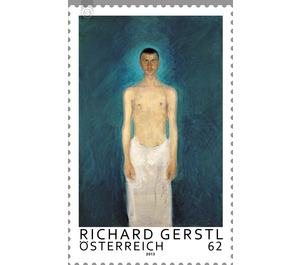Modern Art - Austria / II. Republic of Austria 2013 - 62 Euro Cent
Theme: Art & Culture
| Country | Austria / II. Republic of Austria |
| Issue Date | 2013 |
| Face Value | 62.00 |
| Edition Issued | 400,000 |
| Printing Type | offset |
| Stamp Type | Commemorative |
| Item Type | Stamp |
| Chronological Issue Number | 2419 |
| Chronological Chapter | OOS-OE2 |
| SID | 86356 |
| In 57 Wishlists | |
Richard Gerstl (1883 Vienna - 1908 Vienna) Selfportrait as a Half Act, 1904/1905, oil on canvas, 159 x 109 cm, Leopold Museum, Vienna, inv. 637 The 21-year-old artist himself presents himself as a luminous figure in this work. The frontality of the strict composition is underscored by the mystical blue of the background. Richard Gerstl does not present himself, as is customary traditionally, as a painter with his attributes, but quotes elements of the image of Christ in order to express his self-conception as an artist. As in a sacral representation, the artist is surrounded by a luminous aura. This emphasizes the unreal, almost supernatural aspect of appearance. The self-portrait becomes a symbol of the artist's exposure and loneliness. The symbolic expression of the painting also recalls the works of the Norwegian painter Edvard Munch, whose paintings were exhibited at the Vienna Secession and known to Richard Gerstl. With his self-portrait, the young Richard Gerstl achieved an extraordinarily independent performance. Gerstl was at the beginning of a promising career. In the few years that were granted to the young painter, a rejection of any academic painting tradition is expressed. His willingness to design experiments, ranging from a symbolically expressive style of painting to the demolition of the form, makes him a prophet and pioneer of twentieth-century art. The tragedy in Richard Gerstl's life was an unfortunate love for Mathilde Schönberg, the wife of the famous composer Arnold Schönberg. He had met her in the company of the circle of friends around the fascinating person of the teacher and musician Schoenberg and maintained a romantic love relationship with her for some years. In the summer of 1908, the relationship was discovered by the husband Schönberg, it came to a scandal. Mathilde left husband and children for a short time and fled with the young Gerstl from Feriendomizil on Lake Traunsee in Upper Austria to Vienna, a short time later to return back to her husband. Gerstl had since then not only lost his lover, but also his friends. This isolation may have been the cause of a deep depression, which in November of the same year apparently drove the artist, who was only 25 years old, to suicide. Due to Gerstls retreat from the art scene of his time and his tragic biography, his work was hardly known to his contemporaries. Most of the works existing at the time of his death were stored by the artist's brother in a depot, where they were only rediscovered twenty years later by the Viennese art dealer Otto Kallir-Nirenstein. In 1931, the first exhibition of works by Richard Gerstl took place in the Neue Galerie in Vienna. Since then, the work of this exceptional artist has been regarded by the professional world as a sensation. The Leopold Museum, which focuses on the art of the Viennese turn of the century, today owns the largest closed work collection of Richard Gerstl


